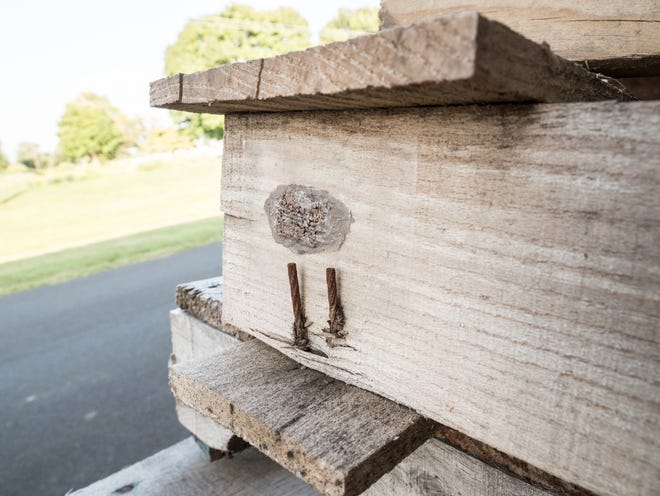It’s that time of year for millions of Americans to channel their inner “Terminator” and say “hasta la vista, baby” to one of the country’s biggest pests: the spotted lanternfly.
In 2014, the invasive species was discovered in the U.S. for the first time in eastern Pennsylvania. Since then, the bug with colorful red, black and brown wings has continued to spread throughout the Northeast, residing in 14 states while causing havoc at the same time.
It’s why federal officials are trying to spread awareness about the spotted lanternfly, as there are concerns it could spread its outreach in the U.S., and cause more pain to residents. It’s already happening this year, with eggs in some places beginning to hatch.
“As it gets warmer, we’re going to start seeing a massive hatch,” Matthew Travis,
National Policy Manager for the U.S. Department of Agriculture, told USA TODAY.
How did the spotted lanternfly get to the US?
The spotted lanternfly originates from China. George Hamilton, extension specialist in pest management at Rutgers University, previously told USA TODAY. Hamilton believes they landed in the U.S. via shipping crate coming from the Asian country.
Why is the spotted lanternfly bad?
Besides inducing fears in those that don’t like bugs, spotted lanternflies actually do cause harm to plant life.
Travis said they feed on more than 70 types of plants, but they have been known dine on grapes, affecting vineyards throughout the Northeast.
Spotted lanternflies could weaken a plant enough that it “just can’t survive,” Travis said.
The bugs also excrete a sugary substance called honeydew “that encourages the growth of black sooty mold,” according to the Pennsylvania Department of Agriculture. Honeydew isn’t harmful to humans, but it damages plants and can leave the sticky substance on someone’s outdoor gear.
Spotted lanternflies also can just be flat-out annoying. Travis said there were several complaints when they overtook New York City last year.
“You didn’t have to read very long to realize that people’s lives are being affected,” he said. “These insects are just all over the place, crawling on all the buildings, they’ll hop on you as an individual.”

Where are spotted lanternflies found?
Since their arrival in the U.S. nearly a decade ago, the spotted lanternfly has migrated west and south, now found in 14 states, per the USDA:
- Connecticut
- Delaware
- Indiana
- Maryland
- Massachusetts
- Michigan
- New Jersey
- New York
- North Carolina
- Ohio
- Pennsylvania
- Rhode Island
- Virginia
- West Virginia
Prehistoric: Giant flying bug found on side of Walmart turns out to be ‘super-rare’ Jurassic-era insect
California: California residents may see more mosquitoes this year. Here’s why.
How is the spotted lanternfly spreading so easily?
Spotted lantern flies have a one of the most deceiving names because they don’t really fly, but rather hop from place to place. So how could something that has trouble being in the air spread so quickly? Because of us, Travis said.
“Human-assisted spreads has really been the main driving force to help disperse spotted lanternfly to all these different states,” he said, “They’re not great fliers, but they do hitchhike.”
Whether it’s by truck, RV or train, spotted lanternflies and their eggs can be placed on anything, and if they are moved, they end up in a new area. Because of their ability to survive transportation, some states have quarantine zones, where “any material or object that can spread the pest cannot be moved without taking precautions to prevent that spread.”
“If you’re in a quarantine area, be aware of it,” Travis said.
Could spotted lanternflies move to West, Southeast?
As officials try to limit the amount of spotted lanternflies in areas they already populate, they consider the possibility the spotted lanternfly expands to the West and Southeast. A 2019 study found the insect’s life could be sustained in every state in the continental U.S. except North Dakota.
“It’s certainly on our minds,” Travis said. “We are concerned that this will continue to move West, and we’re doing our best at the moment – working with our state partners – to try and control and limit its movement as much as we can, as much as possible.”
Federal officials are working “long term controls” for the spotted lanternfly, but Travis said it’s “going to take time” to develop based on research, but raising awareness is their best tool at the moment. Officials are hopeful to minimize the population in the future.
“It’s hard to speculate if are we going to eradicate them,” Travis said. “These long range controls… we think that could help us get to the point where, you may have a few spotted lanternflies, but they’re not really a big deal.
“I think we’re going in the right direction.”
What’s everyone talking about? Sign up for our trending newsletter to get the latest news of the day
What to do if you see a spotted lanternfly or its eggs
Spotted lanternfly eggs typically begin to hatch in May and June, meaning there are likely some egg masses around now.
If you see an egg mass, Travis advises you to report it to your local department of agriculture and scrape it off. The eggs look white and glossy before they turn gray/brown when dried, similar to a smudge of clay, according to the Virginia Department of Forestry.

“That’s anywhere from 30-to-50 new spotted lanternfly nymphs that won’t hatch now,” he said.
As for the adults, the message is the same: take a picture, report it and then stomp.
“Take the extra effort of trying to stomp them or step on them and eliminate them,” Travis said.
Follow Jordan Mendoza on Twitter: @jordan_mendoza5.

